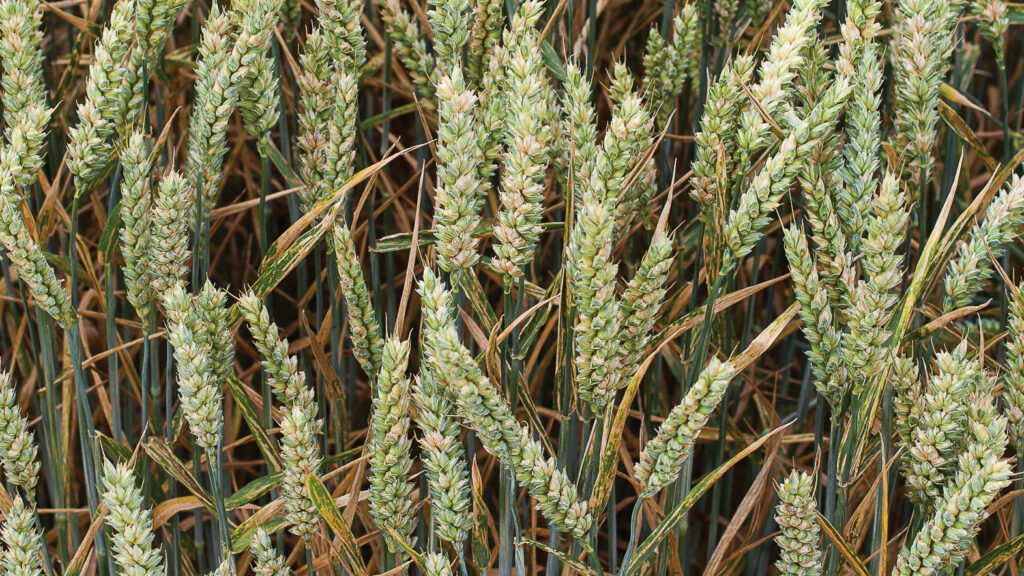What makes the ideal wheat variety for regenerative farming?
 © Blackthorn Arable
© Blackthorn Arable Wheat growers looking for varieties most suited to a regenerative farming system are unlikely to find all the information they need on the AHDB Recommended List, believes one plant breeder.
While untreated yield figures and disease resistance ratings are useful, there’s no data on varieties grown in wide rows and established by direct-drilling, both of which are typical of the approach, says Ron Granger, arable technical manager at Limagrain.
“The question we often get asked is whether we are creating the right varieties for regenerative farming systems,” he reports.
“Putting companion plants in with wheat, for example, may need varieties with a certain growth habit, as may the use of inter-row cultivations.”
See also: Tips to tackle foliar sugar beet disease in high risk season
While recommended varieties are often suitable, there’s a case to be made for selecting better varieties for these systems, adds Ron.
As a result, Limagrain has undertaken some testing work with growers to look at how different variety types may fit, as well as getting the regenerative community to rate the characteristics they are looking for.
Not surprisingly, disease resistance came out top (58%), with rooting ability next (42%) followed by yield (41%).
“What was interesting to us was the finding that 43% of growers said the RL data isn’t extensive enough for selecting varieties for these systems. It was a real ‘could do better’ moment.”
As a result, Ron has come up with a list of attributes that Limagrain considers helpful when trying to pinpoint what’s required:
- Consistency – how does it perform across seasons?
- Yield – do you want high yields or lower yields/better agronomics?
- Disease resistance – are you after very resistant or acceptable resistance?
- Tillering ability – does it maintain tillers?
- Plant ideotype – do you want erect or prostrate growth habit?
- Rooting – will better-rooted varieties help with unpredictable weather patterns?
- New genetics – is barley yellow dwarf virus
tolerance/resistance required? - Grain quality – are the end markets going to be happy?
The company has taken a mix of commercial, near market and non-commercial lines and asked growers for their feedback on their performance in a farm situation, he reveals.
“A variety with a very upright growth habit that is quick to get going in the spring, may be best where companion plants are being grown,” he says. “However, where there’s a need to drill early, such as in the North, you want a slow speed of development and prostrate growth habit.”
Variety blends have been popular with regenerative growers as a way of including greater diversity, Ron acknowledges, but he questions the practice of putting resistant and susceptible varieties together.
“The last thing we want is for resistant genes to be broken. It would seem more sensible to put clean varieties together.”
He highlights Beowulf, Limagrains’s new hard Group 4 variety, as an interesting choice for a regenerative farming system.
“Its untreated yield of 91% tells you quite a bit – it also has very stiff straw and good spring vigour, along with high yields from late sowing. It ticks a lot of boxes.”
The company has previously marketed Typhoon as a good regenerative choice, for very different reasons.
“It’s a true early drilling type and sits close to the ground into the spring, with good disease resistance.”
Breeding for regenerative agriculture
Independent wheat breeder Bill Angus believes there is an opportunity to breed varieties for regenerative agriculture, but stresses that the process needs to be led by the AHDB.
“We breed for this list – if a variety doesn’t get recommended, we don’t get any income,” he points out.
“There’s a huge range of genetic material at our disposal, but the prescriptive nature of the RL system means we don’t always make best use of it.”
A leaner, meaner, more efficient trialling system would help, he suggests, as would engagement with the rest of the world and a national phenotyping centre.
“That would help us to have a short-term impact and be really effective.”
He dismisses the value of heritage varieties in having much to offer to breeding programmes, as the traits that are needed now are complex and multi-gene, so older varieties won’t have been characterised or assessed for them.
“These include water use efficiency, suitability for low-tillage situations, differences in rooting morphology and competitive effects in weed situations.”
